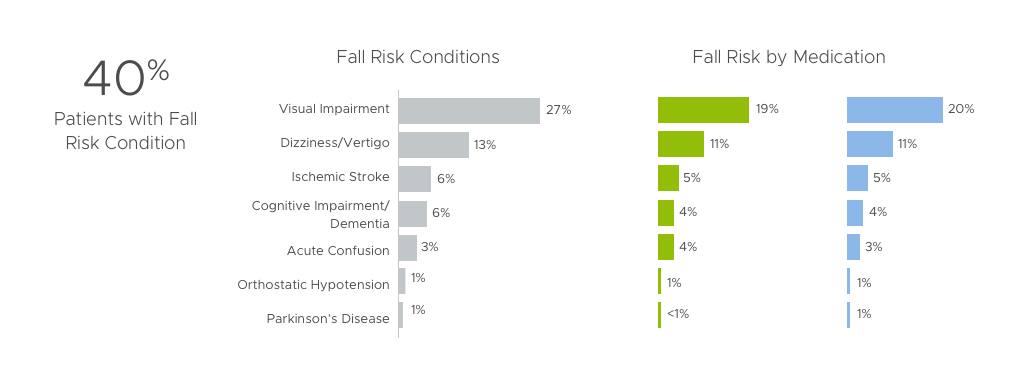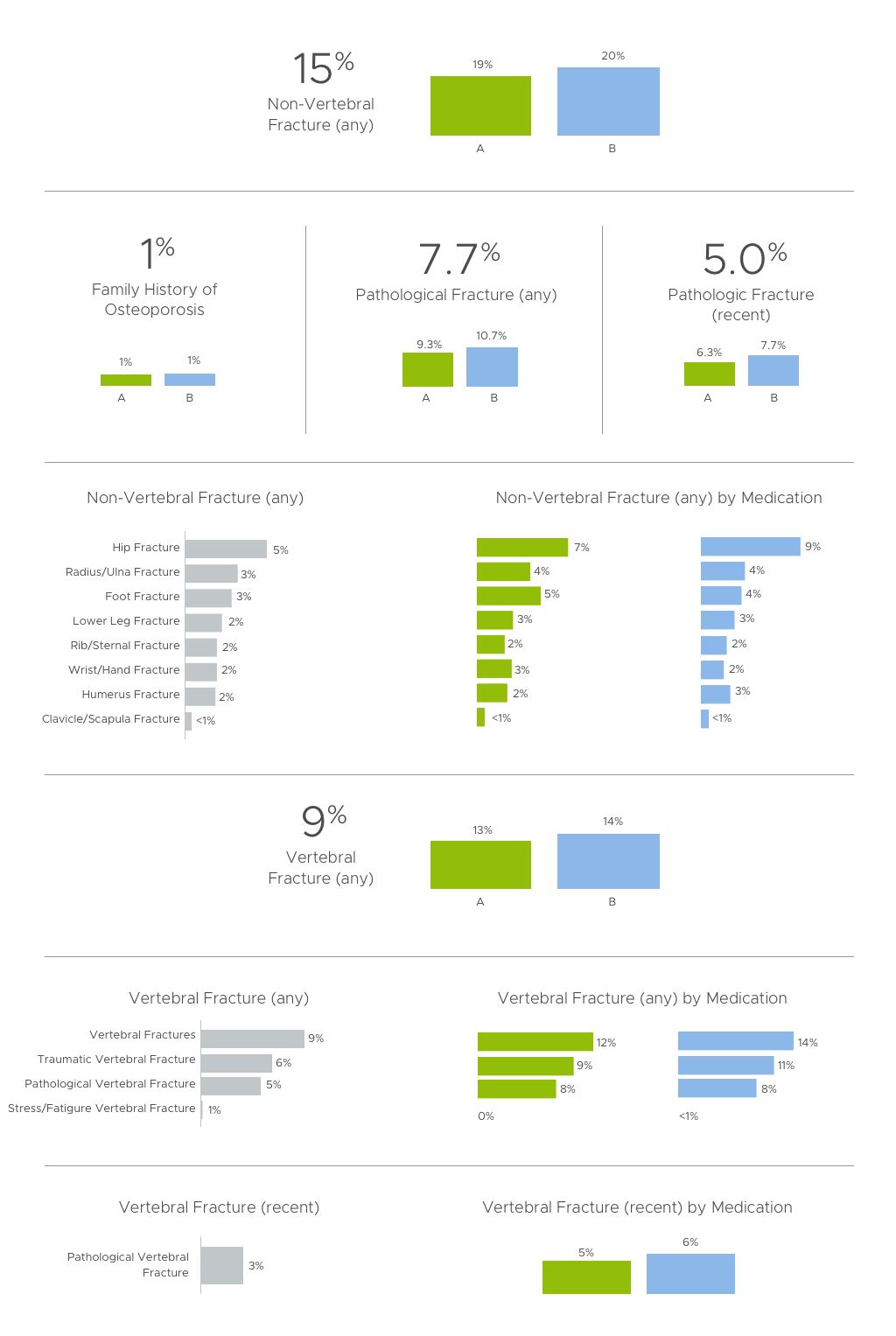Medical History
Download data
Medical History
Download data
Healthcare Provider Specialty at Index Date
 Drug A
Drug A
 Drug B
Drug B

Additional Information
- When prescribing physician is not available, healthcare provider specialties are based on encounters on or around the index date.
Charlson Comorbidity Score at Index
 Drug A
Drug A
 Drug B
Drug B

Additional Information
- Mean Charlson score. Mean Charlson score overall and stratified by medication. The Charlson score is the latest calculation closest to and prior to the index date.
- Median Charlson score. Median Charlson score overall and stratified by medication.
- Categorical Charlson distribution overall. Distribution of the Charlson score across all medications of interest.
- Categorical Charlson distribution by medication. Distribution of the Charlson score by medication
Fall Risk-Related Conditions at Index
 Drug A
Drug A
 Drug B
Drug B

Additional Information
- Percent fall risk. Proportion of patients on the medications of interest who have at least one condition that is associated with having an increased risk of falling, prior to the index date. Conditions included are vertigo, dizziness, acute confusion, cognitive impairment, dementia, Parkinson’s disease, visual impairment, history of stroke and orthostatic hypotension.
- Fall risk distribution. Proportion of patients overall who have at least one condition that is associated with having an increased risk of falling, prior to the index date. Conditions included are vertigo, dizziness, acute confusion, cognitive impairment, dementia, Parkinson’s disease, visual impairment, history of stroke and orthostatic hypotension.
- Fall risk distribution by medication. Proportion of patients who have at least one diagnosis prior to the index date of the specified condition indicating an increased fall risk, stratified by medication. Conditions included are vertigo, dizziness, acute confusion, cognitive impairment, dementia, Parkinson’s disease, visual impairment, history of stroke and orthostatic hypotension.
Diagnostic Procedures
 Drug A
Drug A
 Drug B
Drug B

Additional Information
- BMD - DEXA scan. Proportion of patients overall and stratified by medication who had a BMD - DEXA scan (by procedure code) within 12 months prior to the index date.
- BMD scan. Proportion of patients across all medication and for each medication of interest who had a BMD scan within 12 months prior to the index date. Patients included based on any procedure evidence that a bone mineral density by QCT, U/S or unspecified modality scan was performed.
- CT scan. Proportion of patients across all medication and for each medication of interest who had a CT scan within 12 months prior to the index date. Patients included based on any procedure evidence that a relevant CT scan (e.g., chest, abdomen, pelvis) was performed.
Relevant Past Medical History
 Drug A
Drug A
 Drug B
Drug B

Additional Information
- Relevant condition categories distribution. Proportion of patients across all medications of interest who have at least one diagnosis prior to the index date of the specified relevant condition. Relevant medical conditions include, Asthma, COPD, Rheumatoid Arthritis, Type 1 Diabetes, Type 2 Diabetes, conditions associated with secondary Osteoporosis and gastrointestinal disorders. Secondary Osteoporosis includes malignant neoplasms, Cushing’s disease, anorexia nervosa, bulimia, CKD, chronic liver disease, celiac disease, ulcerative colitis, Crohn’s disease, multiple sclerosis, hyperparathyroidism, hyperthyroidism, primary hypogonadism, status post-organ transplant (includes both diagnosis and procedure codes), status-post bariatric surgery (includes both diagnosis and procedure codes), COPD, chronic malnutrition, premature menopause. Gastrointestinal disorders includes esophagitis, gastroesophageal reflux disease, ulcer, stricture, perforation, or hemorrhage of the esophagus, gastric, duodenal, or peptic ulcer, acute gastritis, duodenitis, GI hemorrhage, nausea/vomiting, dysphagia and malabsorption syndrome.
- Relevant condition categories distribution by medication. Breakdown of patients for each medication of interest who have at least one diagnosis prior to the index date of the specified relevant condition. Relevant medical conditions include, asthma, COPD,rheumatoid Arthritis, Type 1 Diabetes, Type 2 Diabetes, conditions associated with secondary osteoporosis and gastrointestinal disorders. Secondary osteoporosis includes malignant neoplasms, Cushing’s disease, anorexia nervosa, bulimia, CKD, chronic liver disease, celiac disease, ulcerative colitis, Crohn’s disease, multiple sclerosis, hyperparathyroidism, hyperthyroidism, primary hypogonadism, status post-organ transplant (includes both diagnosis and procedure codes), status-post bariatric surgery, COPD, chronic malnutrition, premature menopause. Gastrointestinal disorders includes esophagitis, gastroesophageal reflux disease, ulcer, stricture, perforation, or hemorrhage of the esophagus, gastric, duodenal, or peptic ulcer, acute gastritis, duodenitis, GI hemorrhage, nausea/vomiting, dysphagia and malabsorption syndrome.
- Secondary osteoporosis distribution. Proportion of patients across all medications of interest who have at least one diagnosis at any time prior to the index date of a condition associated with secondary osteoporosis. Secondary osteoporosis includes malignant neoplasms, Cushing’s disease, anorexia nervosa, bulimia, CKD, chronic liver disease, celiac disease, ulcerative colitis, Crohn’s disease, multiple sclerosis, hyperparathyroidism, hyperthyroidism, primary hypogonadism, status post-organ transplant, status-post bariatric surgery (includes both diagnosis and procedure codes), COPD, chronic malnutrition, premature menopause.
- Secondary osteoporosis distribution by medication. Breakdown of patients for each medication of interest who have at least one diagnosis at any time prior to the index date of a condition associated with secondary osteoporosis. Secondary Osteoporosis includes malignant neoplasms, Cushing’s disease, anorexia nervosa, bulimia, CKD, chronic liver disease, celiac disease, ulcerative colitis, Crohn’s disease, multiple sclerosis, hyperparathyroidism, hyperthyroidism, primary hypogonadism, status post-organ transplant (includes both diagnosis and procedure codes), status-post bariatric surgery , COPD, chronic malnutrition, premature menopause.
- Gastrointestinal disorders distribution. Proportion of patients across all medications of interest who have at least one diagnosis at any time prior to the index date of specified gastrointestinal disorders. Gastrointestinal disorders includes esophagitis, gastroesophageal reflux disease, ulcer, stricture, perforation, or hemorrhage of the esophagus, gastric, duodenal, or peptic ulcer, acute gastritis, duodenitis, GI hemorrhage, nausea/vomiting, dysphagia and malabsorption syndrome.
- Gastrointestinal disorders distribution by medication. Breakdown of patients for each medication of interest who have at least one diagnosis at any time prior to the index date of specified gastrointestinal disorders. Gastrointestinal disorders includes esophagitis, gastroesophageal reflux disease, ulcer, stricture, perforation, or hemorrhage of the esophagus, gastric, duodenal, or peptic ulcer, acute gastritis, duodenitis, GI hemorrhage, nausea/vomiting, dysphagia and malabsorption syndrome.
Fractures Prior to Index Date
 Drug A
Drug A
 Drug B
Drug B

Additional Information
- Family history of osteoporosis. Average percent of patients across all medications of interest and on each medication of interest with a documented family history of osteoporosis and/or a history of hip fracture. For each medication the percent of patients is out of the total number of patients with an index date on that specified medication up to the end of the available data.
- Pathologic fracture history. Average percent of patients across all medications of interest and on each medication of interest with a history of pathologic fracture at any time in the available data prior to the index date.
- Pathologic fractures recent history. Average percent of patients across all medications of interest and on each medication of interest with a recent history of pathologic fracture within 12 months prior to the index date.
- Vertebral fractures. Average percent of patients across all medications of interest and on each medication of interest with a history of vertebral fracture at any time in the available data prior to the index date.
- Non-vertebral fractures. Average percent of patients across all medications of interest and on each medication of interest with a history of non-vertebral fracture at any time in the available data prior to the index date.
- Non-vertebral fractures distribution. Proportion of patients across all medications of interest with non-vertebral fractures at any time prior to the index date. Non-vertebral fractures include hip, humeral, lower leg, radius/ulna, and other non-vertebral fractures.
- Non-vertebral fractures distribution by medication. Breakdown of patients for each medication of interest with non-vertebral fractures at any time prior to the index date. Non-vertebral fractures include hip, humeral, lower leg, radius/ulna, and other non-vertebral fractures.
- Vertebral fractures distribution. Proportion of patients across all medications of interest with vertebral fractures. Vertebral fractures at any time prior to the index date include stress, traumatic, and pathologic - vertebral fractures. Pathologic - vertebral fractures is further broken down to only recent fractures, occurring within 12 months of the index date.
- Vertebral fractures distribution by medication. Breakdown of patients fr each medication of interest with vertebral fractures. Vertebral fractures at any time prior to the index date include stress, traumatic, and pathologic - vertebral fractures. Pathologic - vertebral fractures is further broken down to only recent fractures, occurring within 12 months of the index date.
